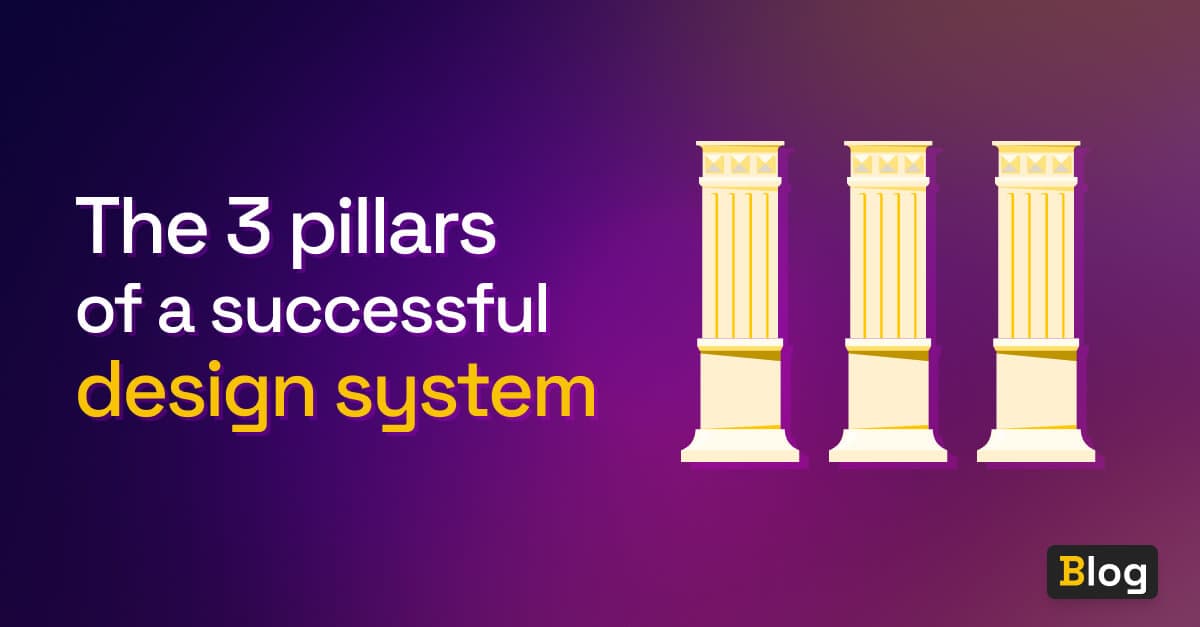
The 3 pillars of a successful design system
No one likes changes, particularly in the tech stack, “if it’s not broken, don’t fix it” most experienced team members will say. What if the new approach doesn’t work? What if it creates new issues? Not surprisingly, the same goes for design systems. Switching from old-school design architecture to a brand new design system can bring tremendous change, not only to your product but also, potentially, to the whole organization.
However, adopting a design system can lead to tremendous benefits: from laying the groundwork for your product to encouraging strong team collaboration. Design systems force teams to develop guidelines for delivering a product to production and can help you get the most out of your team and product.
A design system is more than just a collection of components. It also offers design concepts and guidelines for using the components. It provides good documentation with templates and examples of what to do and what not to do. It includes the component library’s surrounding procedures, strategy and vision. A design system also provides a well-defined governance scheme for who owns or contributes to the design system, as well as a consistent user experience, helping teams to deploy features more quickly, make rebranding changes more efficiently and freeing-up time to deal with complex UX challenges.
On a broader level, the benefits of having a design system can be categorized as follows:
- Reduced cost: having everything in one place reduces the amount of work done by multiple teams.
- Boosted confidence: having clear instructions on developing a given user interface gives the team more confidence.
- Elevated empathy: when everyone in the team contributes to the core design system, it elevates empathy between the teams.
- Defined principles: design systems help designers, developers, marketers and project managers define fundamental design principles.
- Improved productivity: productivity improves immediately when everything originates from a single source.
Build consistent front-end experiences
Building a consistent front-end experience requires a well-documented, standardized set of UI blocks that can help team members to understand the basic foundation on which UI is built. It increases output speed and encourages collaboration among members to develop and implement features in time. Furthermore, because conflicts are less likely to arise, companies can ship features faster than they could without a design system.
Three important factors to keep in mind when using a design system are:
- Make use of open source: not all companies can afford to build a design system from scratch. Instead of consistently building components from scratch, make the most of existing patterns or adopt open source libraries. Before building, ask yourself if it’s covering multiple use cases or solely focused on single-use cases? This also reduces time and encourages reusability; a more sustainable way to build a design system.
Here’s a curated selection of the most important open source component libraries that you can use as a foundation for your design system. Also, check out why you should use open-source component libraries in your design system?
Don’t worry! Backlight is here to support you 🎉
⭐️ Backlight comes with several starter kits to lower the cost of starting a design system. We have starter kits in React, Vue, Svelte, Web Components and more on the way.
- Documentation: a scattered product is always protected by documentation. If sufficient documentation is not available for reference, the reusability of components becomes problematic for a newly onboarded member. Documentation that is well-written can help new members get started. There should be examples and counter-examples provided for each section. Not only is it important to create documentation, but it is also vital to update it on a regular basis.
📗 Backlight has built-in documentation support, so you can write your design system documentation next to your components. Always nearby and painless to maintain.
- Enforcement: design systems require a set of predefined rules to follow, and teams should adhere to the patterns created. Processes that aren’t necessary should be avoided at all costs because they waste time and slow down the process.
😇 Backlight promotes component-driven development with support for Storybook’s component story format.
Keep quality and maintainability under control
A design system not only ensures quality and maintainability but also reduces maintenance costs and streamlines the release process. As the design system evolves, it’s essential to keep an eye out for ways to simplify around us in order to limit the number of designs that aren’t regularly used. Invest in equipment and automated solutions for testing rather than wasting money on non-essential components.
- Release process: according to a study done by Figma’s team, when designers and developers have access to a design system, they finish their goal 34% faster, increasing the pace at which a product is released to market. Increased speed in the release cycle brings the product up-to-date with the competition. It also provides backward compatibility for teams who choose to roll back. An automated build/release procedure based on CI/CD should be implemented. Additionally, all release information should be sent across different channels to ensure that all teams are informed.
🔍 Backlight acts as your design system tooling platform. You don’t need to build a complex CI - update it, improve it or maintain it. We do it for you so you can focus on building the actual value: your design system.
- Feedback loops: surveys should be undertaken at regular intervals within teams to determine what needs to be improved. With these surveys, we can learn about the requirements and priorities that must be addressed as soon as possible. With this well-maintained system, backlog concerns can be addressed with total attention and resolved within a reasonable time limit.
🔁 Reviewing HTML and CSS code only tells part of the story. Backlight speeds up every step of reviews by rendering components as first-rate.
Keep developers and designers in sync
Keeping developers and designers in sync is a big challenge. Both of them should be aligned if we want to deliver a good quality product.
-
Open to contributions: establishing contribution rules can be accomplished by keeping everyone on the same page. Companies with well-established collaboration strategies and high maturity across disciplines may find contribution easier. Contribution in the form of fresh ideas, analyzing consumer behaviour and expressing what is necessary is also essential. From a technological standpoint, a streamlined pipeline for processing pull requests and dashboards for bugs and features should be maintained so that everyone can view the backlogs and advanced features.
Shipping a product made with a design system is not the responsibility of a sole individual. Consistent and collaborative team efforts can give tremendous results.
🍊 Backlight is an online IDE with Git integration.
-
Collaboration: collaboration is a must. Being on the same page and everyone knowing their goal and vision boosts team productivity. There should be room for opinions, and enough flexibility for teams to make decisions. Different opinions can sometimes create chaos, but they should never be a blocker for a team. Creating a strategic plan and timeline that everyone is aware of and following creates transparency. Furthermore, design systems are developed over time. So, if a team encounters a roadblock during development, they can modify the design system accordingly. This prevents other teams from experiencing similar problems in the future. The majority of the work is managed by standard guidelines, which address functionality and ensure that everyone is working towards a common goal.
Backlight embraces collaboration between developers and designers with instant sharing capabilities.
To learn more, you can engage with the Backlight developer community:
👋 Join the official Backlight Discord community
🐬 Follow us on Twitter for latest updates
📩 Subscribe to our YouTube channel
